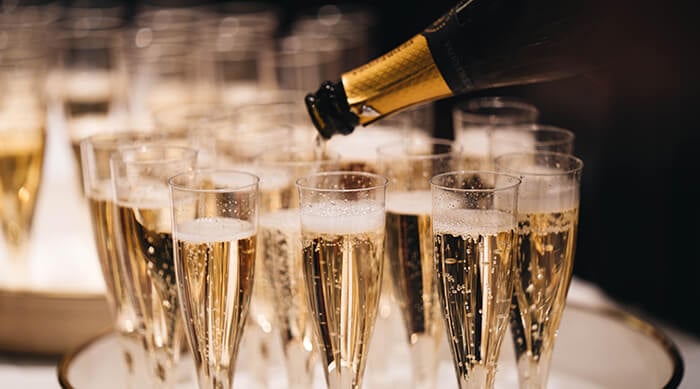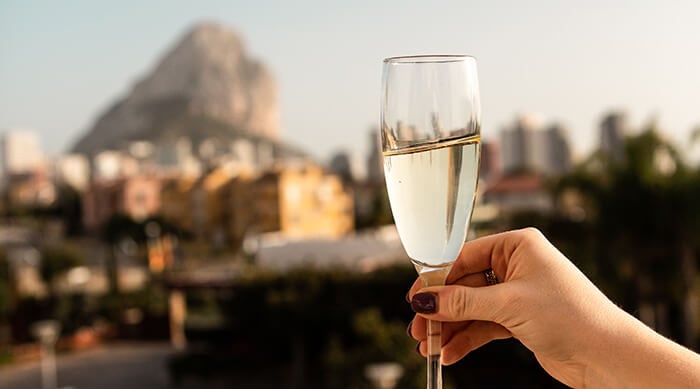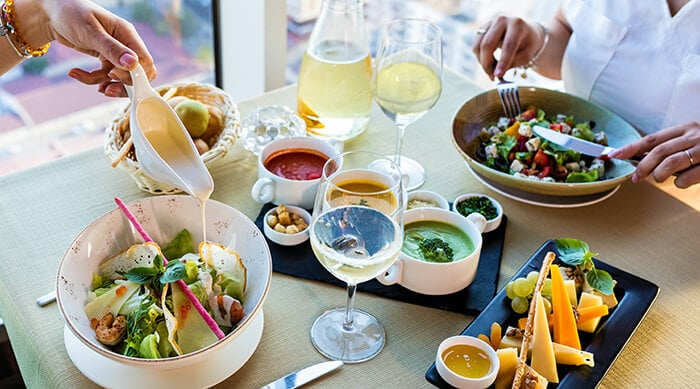Champagne is a bubbly alcoholic beverage from France, often enjoyed during celebrations, milestones, and special occasions.
If you’re not careful, though, those bubbles could go right to your head in the form of a nasty hangover the following day. A bottle of champagne has around 12% alcohol.
It’s important to know where champagne alcohol content falls compared to other alcoholic drinks and the alternatives to champagne if you want to stop drinking or slow down your intake.
Table of Contents
Alcohol Percentage of Champagne
Alcohol in Champagne vs. Other Drinks
Non-Alcoholic Champagne Alternatives
Alcohol Percentage of Champagne
The alcohol content of champagne is about 12% ABV (alcohol by volume). For comparison, wine alcohol content averages 11.6% ABV, and beer is closer to 5% ABV.
Champagne goes through a journey as it’s made since it is fermented twice. Champagne alcohol content is about 9% after the first fermentation and jumps to about 12% after the second fermentation.
During the second round of the fermentation process, winemakers add sugars and yeast to the champagne-in-progress.
This produces those subtle nutty aromas found in most good champagnes and more carbon dioxide bubbles in the resulting bottle of wine.
Can Champagne Get You Drunk?
Yes, you can get drunk with champagne. Your body absorbs carbonation in beverages faster. This means you may get drunk faster from champagne than standard wine when drinking comparable amounts.
One more factor: The faster you drink, the higher your blood alcohol levels rise. Blood alcohol content is based primarily on how many standard drinks you have per hour.
Your glass of champagne may not have a higher alcohol content than liquor-based alcoholic beverages, it’s definitely close to where a typical glass of wine may be. That means moderation is important.
You may even seek alternatives if you’re looking to drink less alcohol.
Alcohol in Champagne vs. Other Drinks
The amount of alcohol in champagne doesn’t vary much, but you’ll generally find that a sweeter style like an asti will have a lower alcohol content than a bubbly on the dry side.
A standard drink of champagne is 4 ounces, typically poured into a 6-ounce champagne flute or glass.
Keep in mind that ABV helps you compare the amount of alcohol in a standard pour or serving. One glass of champagne has alcohol content comparable to a serving of beer or liquor, but the ounces in your glass or bottle will be different.
Is Champagne Stronger Than Wine?
Champagne is not stronger than most wines. Its alcohol content is comparable to most other sparkling wines, rosés, and lighter white wines, like riesling.
Many bolder red wines like cabernets or zinfandels and dry white wines like chardonnay will have more alcohol than sparkling varieties.
Outside of the wine category, there can be vast differences between ABV in alcoholic beverages.
How Much Alcohol is in Champagne vs. Beer?
Champagne is more alcoholic than most beers, although a few very strong beers contain more than champagne’s 12% ABV.
Alcoholic drinks like mead or homemade kombuchas that undergo varied fermentation processes will result in a wide range of ABV totals, as well. Meads can range from a 6-20% ABV depending on what has been added to the batch during fermentation.
Lower ABVs Than Champagne
Champagne falls somewhere in the middle when it comes to ABV, although those bubbles can affect people differently.
Alcoholic beverages with a lower ABV than champagne include:
- Stouts (7-10%)
- Malt liquor (7%)
- IPAs (6-9%)
- Hard cider (4.5-7%)
- Light beer, lagers (4-5%)
- Non-alcoholic sparkling wine (0.5% or less)
Remember, champagne weighs in at 12% ABV.
Looking for a lower-alcohol treat but not ready to give up champagne? 👇
If you’re seeking a good time and a better night’s sleep, non-alcoholic options like ours at Surely are an easy replacement for champagne.
The very low ABV in our wines accounts for trace amounts of alcohol left behind in our dealcoholization process. You’ll find higher amounts of booze in some brands of orange juice!
This is comparable to the amount of alcohol in some brands of kombucha and fruit juice. With this low alcohol content, Surely is often safe to drink even during pregnancy.
However, if you’re expecting or seeking safe drinks while breastfeeding or pregnant, talk to your doctor before making any changes to your diet.
Higher ABVs Than Champagne
Champagne is not the strongest alcohol. Alcoholic spirits will all generally have a high alcohol content and much higher ABVs than champagne.
Spirits and other alcoholic beverages with a higher ABV than champagne include:
- Distilled spirits like vodka, gin, and whiskey (35-46%)
- Fruit liqueurs (28-32%)
- Fortified wines such as port and sherry (17-20%)
- Dessert wine (14%)
- Red wine (12.5-15%)
- Dry white wine (13.5-14.5%)
If you’re seeking alternatives to liquor, there are non-alcoholic spirits out there for you to try in your next mocktail. There are still plenty of flavorful options if drinking alcohol is no longer on your agenda.

Non-Alcoholic Champagne Alternatives
The carbonation in champagne is what makes it feel like such a fun, festive beverage. You don’t need the booze if all you’re seeking is bubbles.
There are a variety of non-alcoholic champagne alternatives out there that are just as enjoyable and won’t leave you feeling less than your best the next morning.
If you’re looking for something that tastes more like the real thing, start with Surely. Our sparkling rosé is the not-too-sweet, effervescent beverage ideal for those limiting their alcohol.
It’s delicious in a mocktail, too. Try non-alcoholic sparkling rosé as a replacement for wine in sangria. You could also use it in a homemade mocktail with fresh fruit or sparkling apple cider.
You won’t miss the alcohol content when you’re enjoying something delicious that doesn’t harm your health.
Champagne vs. Sparkling Wine
Technically, a bubbly beverage is only champagne if it comes from a specific region in France. For the trivia experts among us, “real” champagne comes only from the Champagne region of France.
The grapes used for a traditional champagne are typically Chardonnay, Pinot Noir, or Pinot Meunier grapes. Pinot noir or pinot meunier grapes will boast higher levels of resveratrol, a polyphenol found in the skins of red grapes that gives the body an antioxidant boost.
That doesn’t mean you won’t see “champagne” on the label on a bottle of brut from Oregon or California, though.
While the French, and many wine connoisseurs, may consider these imposters, these brands may not taste much different to you than real champagne. If you’re going for authenticity, though, look for a bottle of French champagne.
A bubbly from elsewhere is still sparkling wine, although there’s also prosecco, the sparkling white wine from Italy, and cava from a specific region in Spain. It’s always safe to just call it sparkling wine.
How Many Calories Are in a Glass of Champagne?
A glass of champagne has about 95 calories in a standard pour of about 4 oz. Sparkling wine will have a similar calorie count, so if you’re seeking to lose weight or watching your sugar, choosing a non-alcoholic alternative can help.
Surely’s non-alcoholic wines have 30-40 calories per serving, making them a healthier option for you all-around.
That all said, every champagne is a sparkling wine, not every sparkling wine is champagne. Every one of them can give you a bad hangover the next morning if you’re not careful.
Looking for bubbles without the buzz?
You can have your bubbles and enjoy yourself, too, without worrying about how you’ll feel the next morning. Surely’s sparkling non-alcoholic options are perfect for all of those celebrations where champagne is often making the rounds. Not sure how to store the wine you didn't finish? Check out our complete guide.
If you’re looking for a champagne alternative complete with bubbles, try our sparkling white. It’s balanced, flavorful, and low-calorie.If you want an alternative to a glass of wine, you may enjoy our non-alcoholic sauvignon blanc or California rosé. We work with winemakers to bring you all of the taste you love without the aftereffects of drinking.






![Sugar-Free Wine Benefits [Low Carb & Keto Considerations]](https://dropinblog.net/34240221/files/featured/sugar-free-wine.jpg)